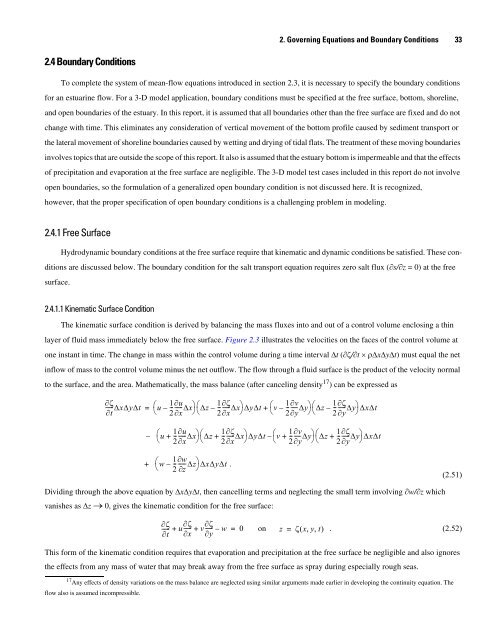A Semi-Implicit, Three-Dimensional Model for Estuarine ... - USGS
A Semi-Implicit, Three-Dimensional Model for Estuarine ... - USGS
A Semi-Implicit, Three-Dimensional Model for Estuarine ... - USGS
You also want an ePaper? Increase the reach of your titles
YUMPU automatically turns print PDFs into web optimized ePapers that Google loves.
2.4 Boundary Conditions<br />
2. Governing Equations and Boundary Conditions 33<br />
To complete the system of mean-flow equations introduced in section 2.3, it is necessary to specify the boundary conditions<br />
<strong>for</strong> an estuarine flow. For a 3-D model application, boundary conditions must be specified at the free surface, bottom, shoreline,<br />
and open boundaries of the estuary. In this report, it is assumed that all boundaries other than the free surface are fixed and do not<br />
change with time. This eliminates any consideration of vertical movement of the bottom profile caused by sediment transport or<br />
the lateral movement of shoreline boundaries caused by wetting and drying of tidal flats. The treatment of these moving boundaries<br />
involves topics that are outside the scope of this report. It also is assumed that the estuary bottom is impermeable and that the effects<br />
of precipitation and evaporation at the free surface are negligible. The 3-D model test cases included in this report do not involve<br />
open boundaries, so the <strong>for</strong>mulation of a generalized open boundary condition is not discussed here. It is recognized,<br />
however, that the proper specification of open boundary conditions is a challenging problem in modeling.<br />
2.4.1 Free Surface<br />
Hydrodynamic boundary conditions at the free surface require that kinematic and dynamic conditions be satisfied. These con-<br />
ditions are discussed below. The boundary condition <strong>for</strong> the salt transport equation requires zero salt flux (∂s/∂z = 0) at the free<br />
surface.<br />
2.4.1.1 Kinematic Surface Condition<br />
The kinematic surface condition is derived by balancing the mass fluxes into and out of a control volume enclosing a thin<br />
layer of fluid mass immediately below the free surface. Figure 2.3 illustrates the velocities on the faces of the control volume at<br />
one instant in time. The change in mass within the control volume during a time interval Δt (∂ζ/∂t × ρΔxΔyΔt) must equal the net<br />
inflow of mass to the control volume minus the net outflow. The flow through a fluid surface is the product of the velocity normal<br />
to the surface, and the area. Mathematically, the mass balance (after canceling density 17 ) can be expressed as<br />
∂ζ<br />
1<br />
-----ΔxΔyΔt u --<br />
∂t<br />
2<br />
∂u ⎛ – -----Δx ⎞ 1<br />
Δz --<br />
⎝ ∂x ⎠ 2<br />
∂ζ ⎛ – -----Δx ⎞ 1<br />
ΔyΔt v --<br />
⎝ ∂x ⎠<br />
2<br />
∂v ⎛ – ----- Δy⎞<br />
1<br />
Δz --<br />
⎝ ∂y ⎠ 2<br />
∂ζ<br />
=<br />
+<br />
⎛ – -----Δy ⎞ΔxΔt ⎝ ∂y ⎠<br />
1<br />
u --<br />
2<br />
∂u ⎛ + -----Δx ⎞ 1<br />
Δz --<br />
⎝ ∂x ⎠ 2<br />
∂ζ ⎛ + -----Δx ⎞ 1<br />
– ΔyΔt v --<br />
⎝ ∂x ⎠<br />
2<br />
∂v ⎛ + ----- Δy⎞<br />
1<br />
Δz --<br />
⎝ ∂y ⎠ 2<br />
∂ζ<br />
–<br />
⎛ + -----Δy ⎞ΔxΔt ⎝ ∂y ⎠<br />
+<br />
w 1<br />
--<br />
2<br />
w ∂ ⎛ – ------ Δz⎞ΔxΔyΔt<br />
.<br />
⎝ ∂z<br />
⎠<br />
Dividing through the above equation by ΔxΔyΔt, then cancelling terms and neglecting the small term involving ∂w/∂z which<br />
vanishes as Δz → 0, gives the kinematic condition <strong>for</strong> the free surface:<br />
(2.51)<br />
∂ζ<br />
----- u<br />
∂t<br />
∂ζ<br />
----- v<br />
∂x<br />
∂ζ<br />
+ + ----- – w = 0 on z = ζ( x, y, t)<br />
. (2.52)<br />
∂y<br />
This <strong>for</strong>m of the kinematic condition requires that evaporation and precipitation at the free surface be negligible and also ignores<br />
the effects from any mass of water that may break away from the free surface as spray during especially rough seas.<br />
17 Any effects of density variations on the mass balance are neglected using similar arguments made earlier in developing the continuity equation. The<br />
flow also is assumed incompressible.

















